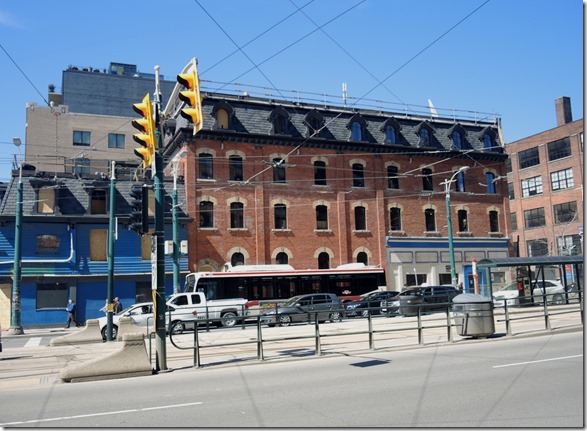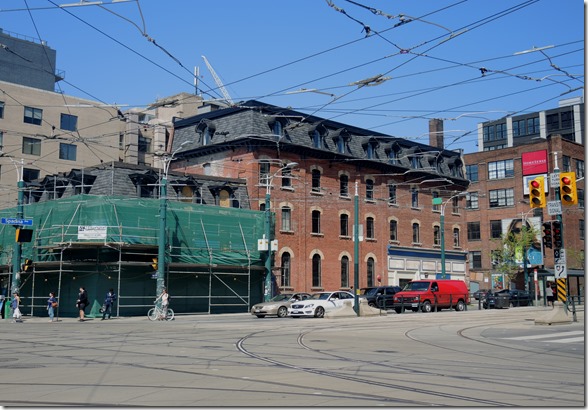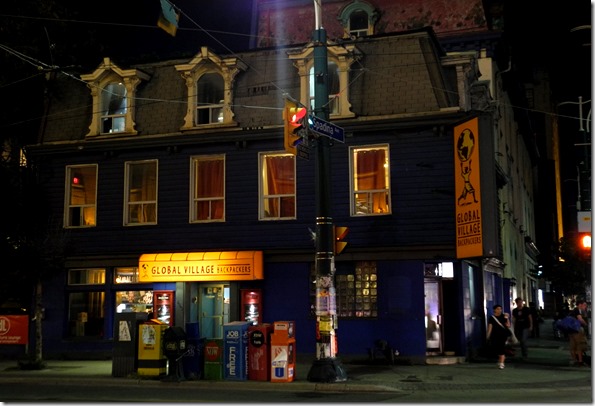In 1873, Samuel Richardson erected a two-storey frame home on this corner. It survives today, though it has been greatly altered. Richardson added a third floor to his home in 1875, it building in the Second Empire style of architecture, with a Mansard roof and ornate gable windows. When completed, he opened the premises as a hotel, naming it the Richardson House. It also contained a tavern to serve the businessmen of the western part of the city. As Richardson had served for eleven years in foreign lands with the troops of the Thirteenth Hussars, he rarely failed to mention this fact when promoting his establishment.
In 1885 a four-storey brick addition was added to the north side of the hotel, on Spadina Avenue, and two years later another extension was added, doubling the number of rooms. The hotel advertised hot-water heating in every room, all for the low rate of $2.00 per day. Weekly boarders received a special rate of $1.50 per day. Samuel Richardson died in 1904. Two year later, it was renamed the Hotel Falconer. Its name was changed again in 1914, when it became Zeigler’s Hotel.
In 1916, it became the Spadina Hotel. In the 1950s, the large room on the second floor, on the north side of the hotel, was redecorated and named the Cabana Room. It became a centre for the avant-garde community of the city. Established artists and students from the Ontario College of Art (today the Ontario College of Art and Design University) congregated in the Cabana room to raise a glass to toast their accomplishments or drown their failures. They vilified, praised, defended, and ignored the latest trends in art. Throughout the decades ahead, many of the young artists established themselves in promising careers in galleries, graphic design firms, and commercial art establishments. Others, similar to the old hotel, fell into obscurity. Such is the way of life in the arts community.
During the mid-1950s, the first-floor dining room was restored to its 1883 splendour, with Canadian walnut and chestnut panelling. The old doors and the wood panelling remained, but the space was a billiard and games room, much removed from its elegant past. Finally, the glorious old hotel became a hostel for student backpackers. It possessed 185 beds available, with four occupants per room. Because of the building’s brightly coloured walls, ornate gables, and garish trim, it was a landmark in the Spadina district.
In 2014, the Backpackers’ Hotel closed and restoration of the buildings commenced, converting it into retail space and offices.
The east facade of the Backpackers’ Hotel on Spadina Avenue in 2012.
The south facade of the colourful Backpacker’s Hotel at King and Spadina in 2012
Where the dining room was located in earlier decades.
Stairs to the old dining room.
The charm of the Backpackers’ Hotel
The former Backpackers’ Hotel under renovations in April 2015.
The restoration work in May, 2015.
Backpackers’ Hotel in 2012.
To view the Home Page for this blog: https://tayloronhistory.com/
To view previous posts about other movie houses of Toronto—old and new
https://tayloronhistory.com/2013/12/18/torontos-old-movie-theatrestayloronhistory-com/
To view links to Toronto’s Heritage Buildings
https://tayloronhistory.com/2014/01/02/canadas-cultural-scenetorontos-architectural-heritage/
Recent publication entitled “Toronto’s Theatres and the Golden Age of the Silver Screen,” by the author of this blog. The publication explores 50 of Toronto’s old theatres and contains over 80 archival photographs of the facades, marquees and interiors of the theatres. It also relates anecdotes and stories from those who experienced these grand old movie houses.
To place an order for this book:
Book also available in Chapter/Indigo, the Bell Lightbox Book Store and by phoning University of Toronto Press, Distribution: 416-667-7791
Theatres Included in the Book:
Chapter One – The Early Years—Nickelodeons and the First Theatres in Toronto
Theatorium (Red Mill) Theatre—Toronto’s First Movie Experience and First Permanent Movie Theatre, Auditorium (Avenue, PIckford), Colonial Theatre (the Bay), the Photodome, Revue Theatre, Picture Palace (Royal George), Big Nickel (National, Rio), Madison Theatre (Midtown, Capri, Eden, Bloor Cinema, Bloor Street Hot Docs), Theatre Without a Name (Pastime, Prince Edward, Fox)
Chapter Two – The Great Movie Palaces – The End of the Nickelodeons
Loew’s Yonge Street (Elgin/Winter Garden), Shea’s Hippodrome, The Allen (Tivoli), Pantages (Imperial, Imperial Six, Ed Mirvish), Loew’s Uptown
Chapter Three – Smaller Theatres in the pre-1920s and 1920s
Oakwood, Broadway, Carlton on Parliament Street, Victory on Yonge Street (Embassy, Astor, Showcase, Federal, New Yorker, Panasonic), Allan’s Danforth (Century, Titania, Music Hall), Parkdale, Alhambra (Baronet, Eve), St. Clair, Standard (Strand, Victory, Golden Harvest), Palace, Bedford (Park), Hudson (Mount Pleasant), Belsize (Crest, Regent), Runnymede
Chapter Four – Theatres During the 1930s, the Great Depression
Grant ,Hollywood, Oriole (Cinema, International Cinema), Eglinton, Casino, Radio City, Paramount, Scarboro, Paradise (Eve’s Paradise), State (Bloordale), Colony, Bellevue (Lux, Elektra, Lido), Kingsway, Pylon (Royal, Golden Princess), Metro
Chapter Five – Theatres in the 1940s – The Second World War and the Post-War Years
University, Odeon Fairlawn, Vaughan, Odeon Danforth, Glendale, Odeon Hyland, Nortown, Willow, Downtown, Odeon Carlton, Donlands, Biltmore, Odeon Humber, Town Cinema
Chapter Six – The 1950s Theatres
Savoy (Coronet), Westwood
Chapter Seven – Cineplex and Multi-screen Complexes
Cineplex Eaton Centre, Cineplex Odeon Varsity, Scotiabank Cineplex, Dundas Square Cineplex, The Bell Lightbox (TIFF)











